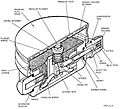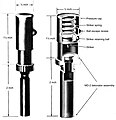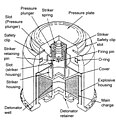How Do You Change Firing Pin In High Standard Pistol


A firing pin or striker is a part of the firing mechanism of a firearm that impacts the primer in the base of a cartridge and causes information technology to fire. In firearms terminology, a striker is a particular type of firing pivot where a compressed jump acts directly on the firing pin to provide the bear on force rather than it existence struck past a hammer.
The terms may also be used for a component of equipment or a device which has a like function. Such equipment or devices include: artillery, munitions and pyrotechnics.
Firearms [edit]

Fired rimfire and centerfire casings, showing the impression left by the firing pin. Note the rectangular impression left by the firing pin on the rimfire cartridge.
The typical firing pin is a thin, simple rod with a hardened, rounded tip that strikes and crushes the primer. The rounded end ensures the primer is indented rather than pierced (to contain propellant gasses). It sits inside a pigsty through the breechblock and is struck by the hammer when the trigger is "pulled". A calorie-free firing-pivot spring is oft used to keep the firing pin rearward. It may be termed a firing-pin return spring, since it returns information technology to the unfired position. In semi-automatic firearms, this prevents premature firing from the inertia of the firing pin equally the breech mechanism closes in the reloading function of the firing cycle. Firing pins of this blazon are ofttimes besides short to contact the primer when the hammer is resting confronting it. This is a safety mensurate to prevent belch from external forces such equally a drop. Firing relies upon the transfer of momentum from the hammer to give the firing pin sufficient impact energy to cause firing.
Type of cartridge [edit]

The two main types of metallic cartridges used in mod firearms are centerfire and rimfire. In centerfire cartridges, the primer is located in the center of the base of operations of the cartridge. Firing pins for centerfire cartridges ordinarily have a round cross-section and their move is usually through a hole in the breechblock along the centrality of the center of the butt's diameter.
Rimfire cartridges however, must be struck on the base about the rim of the cartridge. While rimfire firearms may use a firing pin with a round cantankerous-section, it is common for them to be flat, with a foursquare or rectangular cross-section and a blunt chisel bespeak. Flat firing pins can exist stamped from flat metal stock and usually operate in a slot cut in the breechblock (rather than a hole) that is parallel but offset from the centerline of the barrel. These production methods are generally simpler and reduce production costs. Information technology is generally recommended not to excessively "dry out fire" rimfire firearms (ie firing without a chambered round) every bit information technology is possible for the firing pivot to strike the confront of the camber and deform it or damage the firing pin.
Historical cartridges [edit]

In 1808 by the Swiss gunsmith Jean Samuel Pauly in clan with French gunsmith François Prélat created the showtime cartridges to integrate a primer and be self-contained. The paper cartridge used a metal base with a through-pigsty coated in a percussive priming compound. Pauly also adult a breech-loading shotgun for his cartridge, using a firing pin and external hammer.[1]
The Dreyse needle gun of 1836 uses a paper cartridge with a priming as part of a sabot which cradles the projectile and is forward of the propelling charge. The needle-like firing-pivot projects from the commodities-face and pierces the cartridge when the breech is closed. On firing, the spring-loaded needle strikes the priming in the sabot. Unlike Pauly'due south cartridge, which was non widely accepted, Dreyse's burglarize was adopted by Prussia every bit it'south infantry service burglarize. It was the offset armed services breechloader to utilise a self-contained cartridge and consequently, the first to employ a firing pin.[two] [three]
The pinfire cartridge patented in 1835, uses a metallic cartridge with an integrated firing pin located radially near the base of the cartridge.[4] The pin needs to exist aligned with a corresponding slot in the chamber; a disadvantage compared with rimfire and middle fire cartridges that followed and that are also safer.[ii] [5]
Side-lock hammers [edit]
Early rifle designs that fired metallic cartridges typically used a side-lock mechanism, with the hammer mounted to ane side rather than inline with the axis of the barrel. In the trapdoor Springfield Model 1865 (and similar) the rear of the firing pin tube inside the breechblock is angled away from the centerline of the barrel toward the hammer.[half dozen] The Sharps burglarize uses a firing pin block to solve this alignment problem. The cake sits within a recess in the breechblock. When struck by the hammer, the whole block is propelled forward. That part of the block with the firing pivot sits on the centerline of the barrel and strikes the primer.[7] [eight] [9]
Fixed firing pins [edit]

Many revolvers use a firing pin that is fixed to the hammer. Unproblematic blowback sub-machine guns that burn down from the open-bolt position ofttimes have a fixed firing pin that protrudes from the face of the bolt. As the commodities fully closes on the breech the primer of the newly chambered round is struck, causing the cartridge to fire. The Owen and F1 submachine gun are examples that utilize commodities-face stock-still firing-pins. Some mortars use a stock-still firing pin mounted in the breech plug. When a mortar round is dropped downwardly the butt, a primer in the base of the mortar round strikes the firing pin and ignites the propelling charge.[10]
Floating firing pins [edit]
In firearms terminology, a floating firing pivot is i which is unrestricted by a firing-pivot return spring or similar. While it volition be convict and unable to simply fall out, either frontward or backward, it is otherwise free to slide inside these stops. The trapdoor Springfield Model 1865 is an example of a floating firing pin.[11]
Striker [edit]

The commodities of a Mauser Gewehr 98 field stripped, showing the cock-on-open striker mechanism
Hammer-operated firing mechanisms use a relatively light firing pivot and rely on a transfer of momentum received from a bound-loaded hammer, in the same fashion as a punch or chisel relays the accident from a mallet. In firearms terminology, a striker (or striker mechanism) derives the impact force to strike the primer from a spring interim directly upon the 'firing pivot' - like to a crossbow, where the striker (firing pin) is like the crossbow bolt (pointer). A striker mechanism is very common in bolt activity firearms just not to the exclusion of a hammer-operated mechanisms. It will also exist institute in other deportment where the breechblock reciprocates directly inline with the axis of the barrel.
A striker mechanism will consist of the striker jump (firing spring) and the striker. The striker bound is a relatively strong spring sufficient to initiate firing. A typical striker consists of a narrow striking point, a heavier section that acts as a spring guide for the striker bound, a shoulder to restrain the spring, and a catch piece which is engaged by the trigger sear to hold the leap under tension when "artsy" and ready to burn. The striker leap is compressed between the striker'due south shoulder and the rear of the breechblock. A striker may be assembled from several component; however, the stored energy in the striker spring is transferred directly to the striker and then to the primer without any intermediate transfer of energy or momentum. As striker mechanisms combine both functions of hammer and firing pin in one slice, they are generally considered to be mechanically simpler but are more robust in construction than a typical firing pin.[12]
Many small-scale calibre rimfire bolt action rifles and some centerfire automated weapons (eastward. thou., vz. 58) may appear to have a striker-operated firing machinery simply are actually a blazon of linear hammer. The hammer tin can be likened to that of a pile driver and is mainly independent within the bolt. It is much like the striker already described except that the "hammer" upon which the firing spring acts and the firing pivot are separate units. Confusingly, parts lists volition ofttimes refer to this type of hammer every bit a "striker".[thirteen]
Striker-fired (or similar) commodities action firearms may be classified equally cock-on-close or erect-on-open up.
Cock-on-shut [edit]
When the breech is opened and retracted rearward, the striker is too carried rearward so that the striker take hold of passes over the trigger sear. When the bolt is pushed forward to shut the breech, the striker catch is held past the trigger sear. The firer must close the commodities with sufficient forcefulness to overcome the force exerted past the cocking spring. Notably, the Lee–Enfield and Belgian Mauser erect on endmost as do many pocket-sized calibre rimfire bolt action rifles.
Cock-on-open [edit]
The breech of a bolt activeness rifle is opened by first rotating the bolt handle. In cock-on-open operation, this rotation acts on a cam (similar to the activeness of a screw thread) which retracts the striker, compressing the cocking spring and holding it there. When the cocking handle is rotated closed, the cocking cam disengages just the striker is retained in the artsy position by the trigger sear.
Introduced in Mauser Model 1871, it significantly reduced the risk of adventitious belch upon closing.[14] The arrangement of performance was widely adopted and is used almost exclusively in modern center-fire rifle designs. The Mauser Gewehr 98, the Mosin–Nagant and M1903 Springfield are examples of service rifles using this type of functioning.
Other applications [edit]
Modern era guns in general (and not simply firearms) use a firing pin of some clarification to initiate firing. Mechanical contact fuzes in explosive ordinance volition employ a firing pin or striker to initiate detonation. Such devices include: artillery projectiles, aeriform bombs and state mines. In landmines, non-metallic firing pins, fabricated from ceramics for case, may be used to minimise their magnetic signature.
The M127A1 signal rocket (and other like flares) take a primer in the base of operations of the disposable launch tube. The cap contains a fixed firing-pin inside. The flare is fire by placing the cap over the base and hitting it by manus.[15]
Paw grenades of the type that use a condom lever (such as the M26 grenade) use a striker that is similar to the archetype bound-loaded mousetrap. It is held under tension until the lever is released and then flips over to strike the primer cap. Some chemical oxygen generators apply a primer and mousetrap blazon striker to initiate the chemical reaction.
Images [edit]
-

-

-
-

Military boobytrap firing device from USSR (normally connected to a tripwire) showing integral striker. The detonator on the end is inserted into a block of explosive e.chiliad. Semtex
-

USSR boobytrap firing device—pressure fuze: victim steps on loose floorboard with fuze concealed underneath.
-

Cross-sectional view of the fuze fitted to a German S-mine
-

Cross-exclusive view of an American M2 mine
-

References [edit]
- ^ Wallace, James Smyth (2008). Chemical Assay of Firearms, Ammunition, and Gunshot Residue. Taylor & Francis. p. 24–26. ISBN9781420069716 . Retrieved 31 March 2022.
- ^ a b Wallace 2008.
- ^ Lewis, Berkeley R. (1972) "Small Arms Ammunition at the International Exposition Philadelphia, 1876" in Smithsonian Studies in History and Engineering (xi) Smithsonian Institution Press, Washington, p. v. Archived 19 November 2015 at the Wayback Motorcar
- ^ Early cartridge designs were a composite of metal and paper.
- ^ Kinard, Jeff (2004) Pistols: An Illustrated History of Their Impact, ABC-CLIO, p. 109 Archived 28 May 2016 at the Wayback Auto
- ^ "U.Due south. Armed forces Sprinfield 1873". Numrich Gun Parts Corporation . Retrieved 8 March 2022.
- ^ "1874 Sharps Rifle From Downwards Under Parts - Pedersoli". Cimarron Firearms . Retrieved 8 March 2022.
- ^ "How to Repair the Firing Pin on an 1869 Sharps Rifle - Midway U.s.a. Gunsmithing". YouTube . Retrieved 8 March 2022.
- ^ "Sharps 1874 rifle: firing pin plate bug No 2". YouTube . Retrieved 8 March 2022.
- ^ Other types of drop-fired mortar ammunition have an internal firing-pin and the breech plug is a flat "anvil". The base of the falling round, with its internal firing pin, strikes the anvil and fires the round.
- ^ "SAAMI Glossary, F". SAAMI. Archived from the original on 2008-01-31. Retrieved 2008-02-12 .
- ^ Charles Eastward. Footling. "XD X-Deelicious!". American Cop. Archived from the original on July 23, 2008.
- ^ "Savage / Stevens / Springfield / Fox Rifles 83". Numrich Gun Parts Corporation . Retrieved ten March 2022.
- ^ O'Connell, Robert (2002), Soul of the Sword: An Illustrated History of Weaponry and Warfare from Prehistory to the Present, Free Press, p. 199, ISBN9780684844077
- ^ "Family of Handheld Signals". Project Manager Shut Combat Systems . Retrieved 10 March 2022.
Source: https://en.wikipedia.org/wiki/Firing_pin
Posted by: buttsnessiogs93.blogspot.com


0 Response to "How Do You Change Firing Pin In High Standard Pistol"
Post a Comment